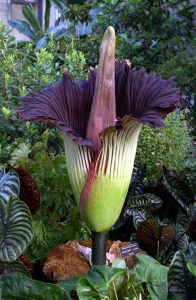The ‘corpse flower’:

Over a thousand people queued up outside an abandoned gas station in San Francisco’s Bay Area this week to catch a glimpse of the extremely rare and aptly named ‘corpse flower’.
- The ‘corpse flower’ is a flowering plant, which is native to the rainforests of Sumatra in Indonesia.
- The scientific name of the rare plant, Amorphophallus titanum, quite literally translates to giant, misshapen phallus — presumably due to its appearance.
- In about a decade, the ‘corpse flower’ can grow to be up to 10 feet tall and unveil two of its key components a deep red skirt-like petal known as the spathe and a yellow rod-like ‘spadix’.
- Another crucial component of the plant is the ‘corm’, a fleshy underground plant stem that acts as a storage organ where the corpse plant’s energy is stored.
- The unique plant is said to have the biggest corm in existence, sometimes weighing around 100 kgs.
- The corpse flower is known to be one of the world’s largest ‘unbranched inflorescence’ or a stalk bearing a cluster of flowers.
- The average corpse flower has a lifespan of about three-four decades.
- Apart from its appearance, the flower is known for its pungent stench, which is said to be similar to rotting meat or a decaying cadaver.
- The plant emits a distinct smell only when it is in bloom, which happens once every 10 years or so and only for a brief period of time.
- The main odorant which gave the flower its distinct smell was dimethyl trisulfide, the same compound that is emitted from cancerous wounds, microorganisms, and some vegetables.




